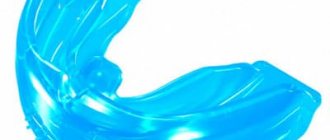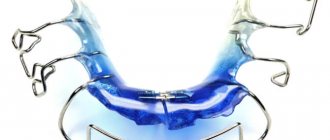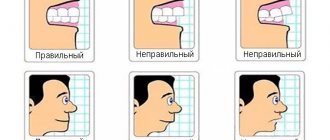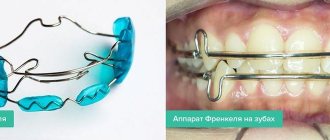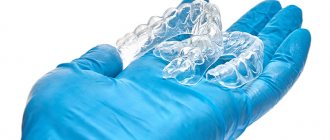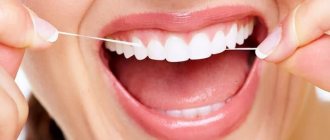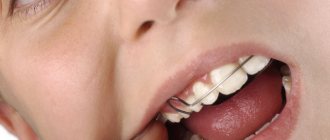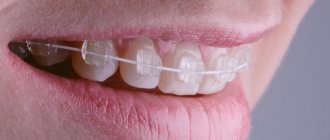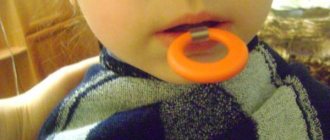A plate for straightening teeth (bracket) looks like a small arch of wire that wraps around the outside of the teeth. This is a removable or non-removable complex orthodontic structure that is installed on the jaw in order to correct aesthetic defects and restore chewing function in case of its impairment or loss.
The device works by applying pressure to the bone tissue. As treatment progresses, the screws will need to be periodically tightened to maintain the therapeutic effect. As a result, in a year or two you can have an attractive, even smile.
What is the name of the teeth straightening plate? The doctor will understand the patient, no matter how he expresses himself. Braces are often confused with retainers, but these designs have slightly different functions.
Indications for use
The device is installed if necessary:
- prevent possible displacement of teeth, keep them in the correct, natural position;
- adjust the shape of the jaw bones or the width of the palate;
- expand interdental distances, get rid of crowding (in children);
- consolidate the result after wearing braces;
- slow down bone growth.
There are also contraindications, but they are few:
- severe mental disorders;
- some respiratory tract disorders;
- allergy to the metal from which the device is made;
- exacerbation of periodontal diseases.
If the oral cavity is not sanitized, there are caries, problems with the gums, the enamel looks bad: before you start wearing a child or adult plate to straighten teeth, you need to get rid of concomitant diseases.
What other features do the plates have?
Yes, you can find a lot of laudatory reviews about plate treatment. But when exactly are they good?
The indications for orthodontic plates are:
- correction of the jaw shape;
- changes in the position of the incisors;
- abnormal change in the rate of jaw growth;
- change in the width of the sky.
When is the best time to bet
The device is used both at a young and at a more mature age, depending on the needs of the client. If there are no significant jaw defects and only supportive or consolidating therapy is required, such a design can be used in adult patients, but they are given only non-removable versions - the removable version does not provide sufficient pressure on the formed dentition to keep it in its normal position.
When are plates placed to straighten children’s teeth, how are they made, what are they called and what are they needed for? The optimal option is considered to be 5–6 years old; sometimes the device is installed on children (3–4 years old), but the final decision is made only by the dentist. It is popular to use a lightweight orthodontic device instead of braces in adolescence, up to 12 (less often up to 15–16) years - mainly to correct minor malocclusions and alignment problems.
In adulthood, dental correction is performed using more complex systems or aligners, but there are cases when the use of arches is prescribed for adults.
A little about why the bite can form incorrectly and how to avoid it:
Types of designs
What types of plates are there for straightening teeth (in particular for children), what are they called and what do they look like? There are several types of dental braces - they are selected by the doctor during a preliminary examination, depending on the severity and nature of the defects, as well as the characteristics of the patient’s lifestyle.
The main classification is the division into removable and non-removable devices. Removable ones are not as effective as fixed ones, but are more convenient to use - you don’t have to wear them when they cause severe inconvenience, you don’t need to eat in them, and you can easily remove them for cleaning or tightening.
Fixed
These dental plates look almost like braces and are metal arches equipped with locks.
They are installed in adults to correct the straightness of the dentition. Depending on the need, the dentist may suggest one of the following options:
- Single-jaw - in them the design is supplemented with one or more screws, which are tightened from time to time. They are used if the dentition is shortened or narrowed.
- With retraction arch on a plastic base. The wire springs, creating the desired effect. Such a device can be installed on both the upper and lower jaw to correct its frontal part.
- With a hand-shaped process, the function of which is to apply pressure on the dental neck for greater efficiency. Used to correct individual visible defects.
- Bruckle's apparatus. This plate for straightening teeth looks like a regular brace, but it is additionally equipped with an inclined plane and a spring arch.
- Andresen-Goipl activator. It is used in pediatric dentistry when bone tissue is not growing fast enough by stimulating its growth. Able to correct bite.
- Frenkel apparatus (also helps young patients), consisting of cheek shields, lip pads (for lip retraction) and a durable frame. Designed to correct defects in the anterior part of the jaws.
Removable
These structures are simpler than non-removable ones and are usually made of plastic; the function of fasteners is performed by metal hooks, and sometimes there are additional screws and springs. Correcting teeth with plates that can be removed usually takes longer, and they are used only in simple cases when a significant change in the condition of the dentition is not required. Such devices are worn mainly by children, often as rehabilitation after more serious orthodontic treatment with braces (instead of retainers).
Rules for tightening the orthodontic plate
To increase the efficiency of the plate, when using it, you should tighten the screw on the base of the device from time to time.
This is done like this:
- remove the device;
- insert the key;
- make a full turn in the direction of the arrow.
This is necessary to increase the load on the bones, and therefore speed up the therapy process.
The specialist installing the device will tell you how often to tighten the screw. This frequency is determined by how quickly the defect is corrected. The interval can be equal to a couple of weeks, or even one to one and a half months.
Differences between removable and permanent braces
The first can be considered a lightweight option. Such arcs:
- cheaper than those that cannot be removed independently;
- not very effective for noticeable problems, more suitable for maintenance therapy.
What does a removable dental plate look like? This is a structure made of soft plastic, it is attached to metal hooks by the teeth. Children's options are often decorated with sparkles or made colorful to make them more pleasant for the child to use.
An undoubted advantage is that this option can not be worn all the time, getting rid of the device during meals, and in some cases during sleep (as prescribed by a doctor). However, they need to be used as often as possible, otherwise there will be no visible effect: sometimes even a break of one day significantly complicates the treatment.
How are the plates installed?
Here is the algorithm for the first installation of the plate, as well as getting used to the device.
| Stage | Description |
| First stage | An impression and x-ray of the jaw are taken. |
| Second phase | The specialist makes the design. |
| Third stage | At the next appointment, the product is installed on the patient’s jaw. Moreover, for the first time the device should be installed under the supervision and control of a specialist. Firstly, the small patient must figure out how to install the device, and secondly, the plate may have some errors, and the doctor corrects them immediately. |
| Fourth stage | The child gets used to the device. This device is a foreign body to the body, so it will cause discomfort at first. More specifically, pressure and pain. However, the fact that a child will endure this is not too high a price to pay for the beauty of a smile when he grows up. How long it takes to get used to is a purely individual matter, since it is determined by several factors at once - the pain threshold, the characteristics of the teeth and gums, and the patient’s mood. This usually takes three to five days. |
The device should be well looked after, otherwise it may become deformed and break.
Installation
Before an impression of the teeth is made for the plates and they are placed (put on), the patient undergoes a complete dental and orthodontic examination, including x-rays of the entire jaw. Afterwards, plaster models are individually made, on the basis of which the arches are made. The structure of the oral cavity of each patient is unique, and it is impossible to use braces created for one person in the treatment of another. The base of the structure should tightly grip the gums and dental contour, and the structure itself should securely fix the device in the desired position, applying pressure to the places that require correction.
How to use a dental plate correctly
The system must be cleaned regularly - the formation of plaque and stone on it leads to inflammation and the development of caries. If you are using a removable version, leave it in a disinfectant solution about once a week overnight.
If the design requires a screw, it must be tightened and lubricated as necessary.
If the braces are removed, it is permissible to remain without them only during meals and daily hygiene (sometimes also during sleep), even if they cause discomfort: without constant impact on the jaw there will be no desired effect. Before a person, especially a child, gets used to the plates on their teeth, they need an adaptation period - on average, one and a half to two weeks. However, there should not be severe pain and friction: if they are observed, you should contact your dentist.
If problems arise with the device, you must immediately make an appointment with an orthodontist, since a break in treatment can negatively affect its outcome. Often, fixing the problem is not difficult (only a specialist should do this), but in some cases it is necessary to completely replace the structure.
Photos before and after wearing a dental plate - what the result of treatment looks like
Treatment of malocclusion or dentition is not a quick process, but the result speaks for itself. For example, here are the “after” photos.
How long to wear the design
Before the doctor installs plates on the teeth of children or when he places them on adults, he makes a preliminary calculation of the time it will take to treat the pathology. This period is approximate and can be reduced or increased depending on the individual reaction and speed of curvature correction. On average, a non-removable system is worn for a year or two, followed by the installation of a retainer to consolidate the result (it is used for as long as possible). If the arch is installed for a child whose jaw is at the stage of formation, most likely, the device will require replacement approximately every six months.
To obtain accurate information on how long and how to wear dental plates correctly, you need to see at least the first results of treatment.
Until what age is it recommended to have braces?
It is recommended to install braces until the age of twenty-five. Until this age, a person’s teeth are actively growing. And they develop. It is easier for children to correct them than for adults.
When a person reaches twenty-five years of age, this can lead to serious problems. The tissue may become very stiff. As a result, the teenager's jaw will be formed. And it will be very difficult to correct the bite. After putting on braces, a teenager will have to have his teeth treated for a very long time. You will have to wear braces for 24 months or more.
It is not recommended to get braces after twenty-five years of age. Because there is a risk that you will have to wear the plate for the rest of your life. To keep your teeth straight.
How to Care for Braces
The basic principle of caring for fixed arches is thorough cleaning several times a day using a brush and floss (dental floss). In the case of removable ones, the process is a little more complicated. Necessary:
- When eating, remove the system, after (before putting it on) - thoroughly clean and rinse the mouth;
- do not forget about weekly deep cleaning of the device using special solutions and gels;
- Strictly follow the dentist’s recommendations regarding the regular use of the device - depending on the severity of the pathology and design features, you need to wear it for several hours a day.
If the arc is equipped with a screw, it should be regularly treated with vegetable oil to prevent it from stagnating, and then carefully turned clockwise and counterclockwise.
For children
How to wear a dental plate for a child depends on the age at which it is placed. Here, too, you need to listen to your specialist. The parents’ task is to ensure that their son or daughter puts on the device on time and does not take it off without the knowledge of their elders (for example, at school or kindergarten). In the event of a breakdown, you should immediately consult a doctor for repair or replacement.
A child's jaw needs less time to change, so the screw will have to be tightened more often than in the case of an adult patient. It is important to monitor uniform pressure on the dentition and control the degree of bite correction.
A plate for a child’s teeth may differ in design from the “adult” version - they are made in color and the metal is decorated with sparkles. Due to this, children's devices are often more expensive than conventional ones, but this can be justified: if you make the medical device an analogue of jewelry, it will be easier for the little patient to get used to it, and he will become less capricious from the need to wear an orthodontic device in his mouth.
For adults
People over 16 years of age are most often given not lightweight thin arches, but braces or aligners that resemble sports mouth guards (if a removable option is needed), but there are situations when the doctor chooses braces - usually this happens if the patient does not require extensive treatment. It is easier for an adult than for children to explain how to properly put a plate on their teeth and remove it, how it works - in the future it is enough just to follow these recommendations and not forget about hygiene.
Consumer Reviews
Levi (otzovik.com)
“The issue of children's toothpaste seems trivial until the day comes when it is needed. On the one hand, it’s clear that in our childhood our parents didn’t have such problems, I remember very well how in preschool age the dentist recommended brushing your teeth with a brush and soap) But since now is the age of information and the Internet, you go into at least a little depth into any question concerning your beloved children .
Therefore, first is a list of my requirements for children's toothpaste:
1) lack of SLS;
2) lack of fluoride, so the child often swallows the paste;
3) a small degree of abrasiveness, as well as the absence of calcium carbonate (chalk) and sodium bicarbonate (soda) responsible for it.
Asepta Kids toothpaste initially came to our house in a promotional tube. My son is conservative in his habits - he looked sideways at the new mini-tube with disbelief for a long time, then he tried it and ordered to buy him just such a paste.
After studying the composition and description of the toothpaste, I came to the conclusion that manufacturers of children's toothpastes know better than parents. In large letters and in plain text they write what their paste does not contain:
The degree of imageability is not indicated by a number (it should be within 50), but by general words, forming - silicon dioxide.
Contains no: fluorine, SLS, parabens. This is confirmed by the fact that the paste hardly foams.
The color of Asepta Kids paste is calm, slightly yellowish:
The taste is described as tutti fruiti - indeed, it resembles a sweetish candy, the rough particles are well felt.
The smell is the same as the taste, sweetish.
It is squeezed out neatly and easily, the child can easily go through the whole process on his own.
After brushing, my teeth are white and beautiful, I hope Asepta Kids will help keep them that way.”
Eoleksa (otzovik.com)
“Good afternoon to all visitors and guests of the Otzovik website!
We bought new toothpaste for our grandchildren. This time we decided to make a purchase at a pharmacy, and not at a regular shopping center. The choice fell on Aserta toothpaste; the toothpaste is not cheap.
This brand was presented with pastes for both children and adults. Rpsta in the form of a gel, soft, pleasant aroma. The kids like it. main properties: preventing caries and helping to strengthen tooth enamel. Children's volume - 50 ml. The design is so-so for me - nothing special. On the package itself there is a paper label with the price and expiration date.
The tube itself looks identical, after squeezing out the paste it becomes shapeless, especially since only children use it. The tube indicates the age for which this toothpaste is intended - we fit exactly into this category - 5.7 years.
The paste is of an unusual color, perhaps depending on the composition of the product (the paste contains extracts of aloe, chamomile, witch hazel), which is why the color is so “medicinal”. Since children like the aroma of the toothpaste, they brush their teeth with pleasure, but they need to be constantly reminded not to forget about this hygiene procedure.
I recommend this paste for purchase for several reasons:
- contains calcium (it strengthens tooth enamel, prevents the penetration of microbes)
- there are components that prevent caries,
- pleasant aroma, economical use,
- protects the child's gums from inflammatory processes. I think this is quite enough."
Retention devices after removing braces
Even high-quality orthodontic intervention is not a guarantee that after the correction is completed, the situation will not return to its original course and the curvature will not return. To minimize the risk of this, after wearing the system (usually one and a half to two years), supporting and consolidating therapy is used, since the elements of the jaw retain increased mobility and tend to return to their old position. Typically the process lasts several years, 1.5-2 times longer than treatment - this is exactly what a dental plate is for.
The use of an arch does not involve such discomfort as the use of a brace system, and after it, the result will be almost unnoticeable. Also, it will not cause inconvenience to a person who is accustomed to careful oral care.
Not only wire elements can be used as a retainer, but also mouth guards that are placed on the teeth. The number of hours in a day during which a retention device must be worn is determined by the doctor based on the mobility of the patient’s jaw.
Useful tips
Because orthodontic plates are foreign bodies, the child may want to have them removed. Parents should keep this under close control. They must explain to their son or daughter that wearing this unpleasant device for a long time is required so that the teeth later look smoother and more beautiful.
If your child removes the plates frequently, the results will be delayed and they will have to wear them longer. The child should carefully monitor dental hygiene, brushing them twice a day. The plate must be removed during the procedures.
Important ! The device must be treated daily with one product, and weekly with another.
Advantages and disadvantages of records
The advantages of fixed orthodontic braces include:
- effectiveness against malocclusions, gaps, grouping;
- relatively low cost;
- no need for active patient action (especially important for children - it is enough to follow simple operating instructions);
- the ability to save the entire row without removing the “extra”, as before braces;
- expansion of the jaw (in children), so that subsequently the permanent incisors and molars erupt correctly and do not interfere.
Before you start wearing dental plates, you should familiarize yourself with the list of potential inconveniences:
- ineffective for significant pathologies;
- the possibility of an allergic reaction to plastic or metal alloy components;
- risk of gum inflammation (in this case, consultation with the treating orthodontist is required);
- discomfort when wearing (especially initially);
- the likelihood of a change in diction (the patient will have to adapt to the new state and not plan important meetings during the adaptation period);
- lack of aesthetic appeal (it is better to find out in advance everything about the condition of the teeth and clarify what a dental plate looks like for a child or adult).
How effective are the devices?
If the problem is not advanced, arches are enough to get an even, beautiful smile and get rid of defects. Only an orthodontist can give the most accurate forecast - he will also advise which device should be chosen.
The best option is to use the design at a young age, as this reduces the likelihood that repeated correction will be needed after adulthood. The doctor will select the optimal wire thickness to achieve the effect.
HAAS device
The most common and convenient to use for both parents and doctors is the non-removable HAAS device. The device is fixed to the temporary teeth on the upper jaw by an orthodontist; it is absolutely invisible to others, but clearly and quickly performs its task. The most successful and appropriate time to work on it is when the central incisors are replaced with permanent ones, i.e. at the age of 7-8 years. The expansion of the upper jaw is carried out through the work of a screw, which the parents themselves tighten based on the recommendations of the attending physician.
Cost of dental plates
For a minor citizen of Russia, the service can be provided free of charge upon presentation of a compulsory medical insurance policy - this is included in the territorial program of state guarantees for the provision of medical care (although sometimes you have to wait). Before children have plates placed on their teeth, impressions are taken of them.
In different commercial organizations, the price varies from 7–10 to 30 thousand rubles, depending on the configuration and complexity of the case. Some devices can be more expensive than conventional arches: for example, a Frenkel apparatus can cost up to 22 thousand, and a single-jaw design can cost differently depending on the number of screws in it.
Specialists at the Dentika clinic invite patients for consultations and installation of orthodontic systems that correct the bite and dentition. We will tell you in detail about how it works, looks, is called and what a plate does for straightening teeth for children and adults, what type of bite it is placed on, and we will help you choose an option that suits you. We work in Voronezh 7 days a week and are always ready to provide qualified assistance!
